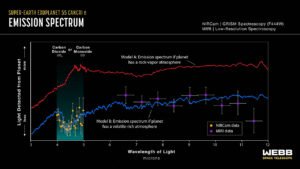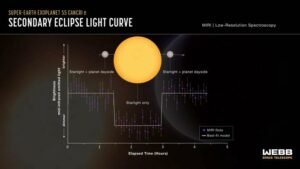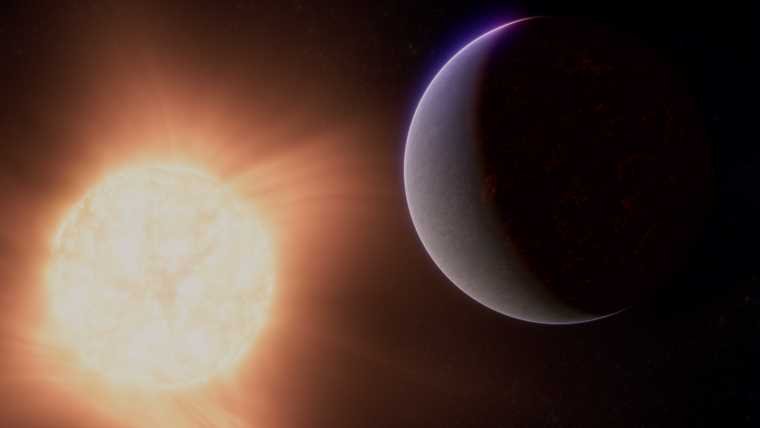Researchers from NASA’s Jet Propulsion Laboratory (JPL) say the James Webb Space Telescope has detected the ‘best evidence to date’ for a rocky exoplanet atmosphere outside of our solar system.
Previous studies of planet 55 Cancri e, a rocky exoplanet about 41 light years from Earth, performed by the retired Spitzer Space Telescope had hinted at the possible existence of a gaseous atmosphere. Still, those studies could not rule out other natural processes that could account for the readings.
NASA says the confirmation of an atmosphere around a rocky exoplanet this cosmically close to home is yet another success for Webb, and raises hopes that the cutting-edge space observatory might one day discover signs of life on a distant planet.
“Webb is pushing the frontiers of exoplanet characterization to rocky planets,” said JPL’s Renyu Hu, the lead author of the paper outlining the historic find. “It is truly enabling a new type of science.”


Illustration: NASA, ESA, CSA, Joseph Olmsted (STScI) Science: Renyu Hu (JPL), Aaron Bello-Arufe (JPL), Michael Zhang (University of Chicago), Mantas Zilinskas (SRON Netherlands Institute for Space Research).
Previous Data Hinted at a Rocky Exoplanet Atmosphere
While 55 Cancri e (also known as Janssen) is a rocky exoplanet, it is hardly a twin to Earth. It is approximately twice Earth’s size and orbits only 1.4 million miles from its host star. For comparison, Earth orbits 93 million miles from the sun. This extremely close orbit means that 55 Cancri e is likely tidally locked, leaving one side always facing its host star. The resulting intense stellar radiation likely keeps the planet’s surface in a molten lava-like state.
Of course, all of this information has been gleaned from reading the light coming from the planet and its host star since even our best telescope cannot image it directly. In fact, before Webb, the best tools available could only guess at the presence of an atmosphere.
“I’ve worked on this planet for more than a decade,” said Diana Dragomir, an exoplanet researcher at the University of New Mexico and co-author of the study. “It’s been really frustrating that none of the observations we’ve been getting have robustly solved these mysteries.”
Researchers using Spitzer found possible light signatures for oxygen, nitrogen, and carbon dioxide. However, the instruments could not rule out other causes for their readings, especially since the planet’s molten surface could generate a “tenuous shroud” of vaporized rock filled with things like silicon, iron, aluminum, and calcium. “The planet is so hot that some of the molten rock should evaporate,” explained Hu.
Detection is Another Win for Webb, Search for Life
To either confirm or refute the presence of a rocky exoplanet atmosphere around 55 Cancri e, the JL team employed two of Webb’s most powerful instruments: NIRCam (Near-Infrared Camera) and MIRI (Mid-Infrared Instrument). Together, these powerful tools were able to scan infrared light coming from the planet in the 4-12 micron range.
As soon as the first sets of results came in, the team knew they were on the right track. The temperature on the star-facing side of the planet was not the expected 4,000 degrees Fahrenheit but instead appeared to be much lower.
“The MIRI data showed a relatively low temperature of about 2,800 degrees Fahrenheit [~1540 degrees Celsius],” said Hu. “This is a very strong indication that energy is being distributed from the dayside to the nightside, most likely by a volatile-rich atmosphere.”
The data captured by NIRCam also revealed light patterns that are consistent with the presence of a volatile-rich atmosphere.


“We see evidence of a dip in the spectrum between 4 and 5 microns — less of this light is reaching the telescope,” explained co-author Aaron Bello-Arufe, also from NASA JPL. “This suggests the presence of an atmosphere containing carbon monoxide or carbon dioxide, which absorb these wavelengths of light.”
Combined, these detections not only offer the best evidence yet for a rocky exoplanet atmosphere, but the researchers behind the effort say it also shows that dedication and persistence can pay off. Although the team admits that 55 Cancri e is likely way too hot to support life as we know it, they do believe that studies proving Webb’s abilities to detect a rocky exoplanet atmosphere like this one are key stepping stones toward that search.
“Ultimately, we want to understand what conditions make it possible for a rocky planet to sustain a gas-rich atmosphere: a key ingredient for a habitable planet,” said Hu.
Until then, the team says this is a significant discovery that serves as tangible proof that patience, determination, and a little help from Webb can pay off.
“We’ve spent the last ten years modeling different scenarios, trying to imagine what this world might look like,” said co-author Yamila Miguel from the Leiden Observatory and the Netherlands Institute for Space Research (SRON). “Finally getting some confirmation of our work is priceless!”
“I am thrilled that we’re finally getting some answers!” Dragomir agreed.
Christopher Plain is a Science Fiction and Fantasy novelist and Head Science Writer at The Debrief. Follow and connect with him on X, learn about his books at plainfiction.com, or email him directly at christopher@thedebrief.org.

